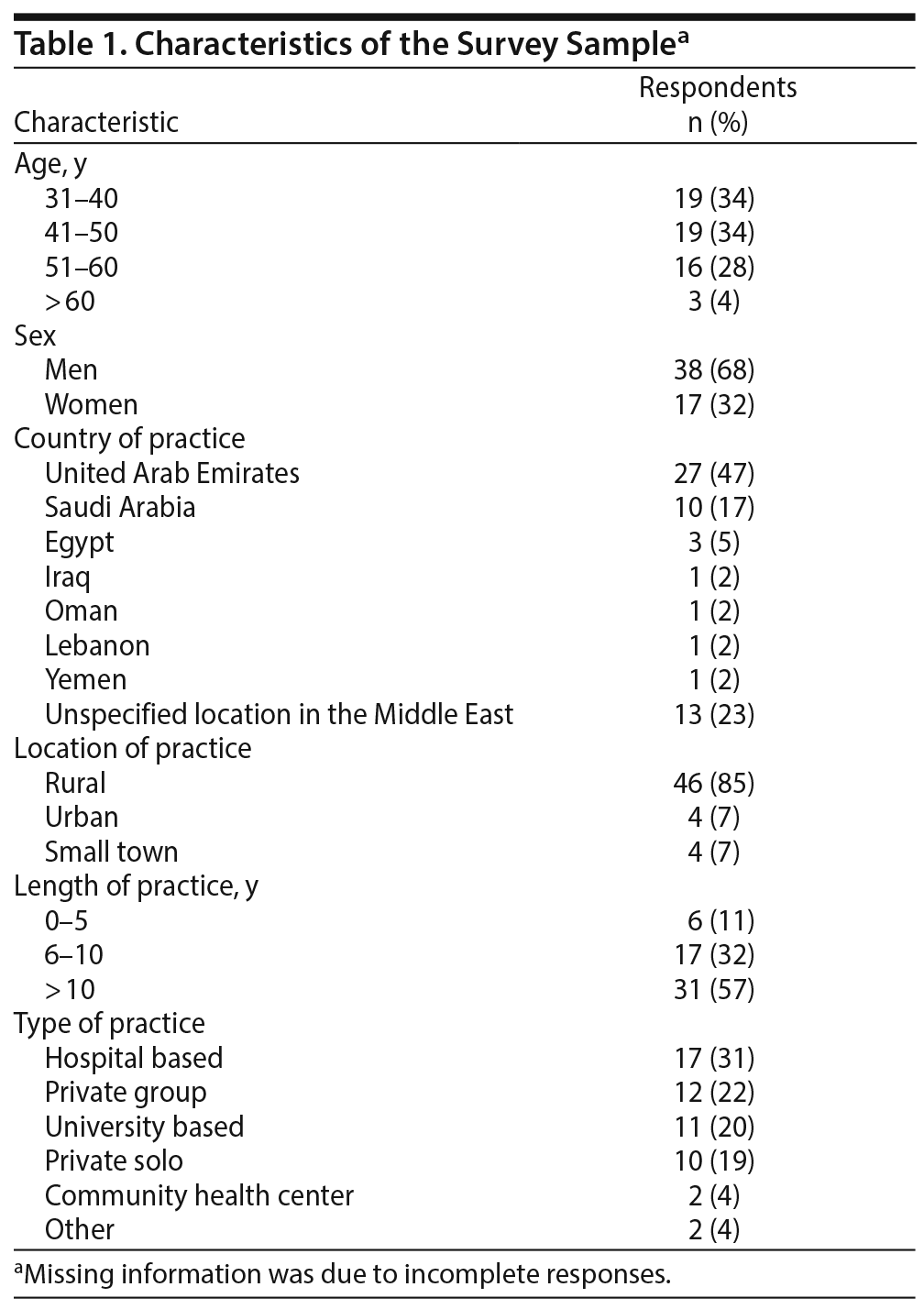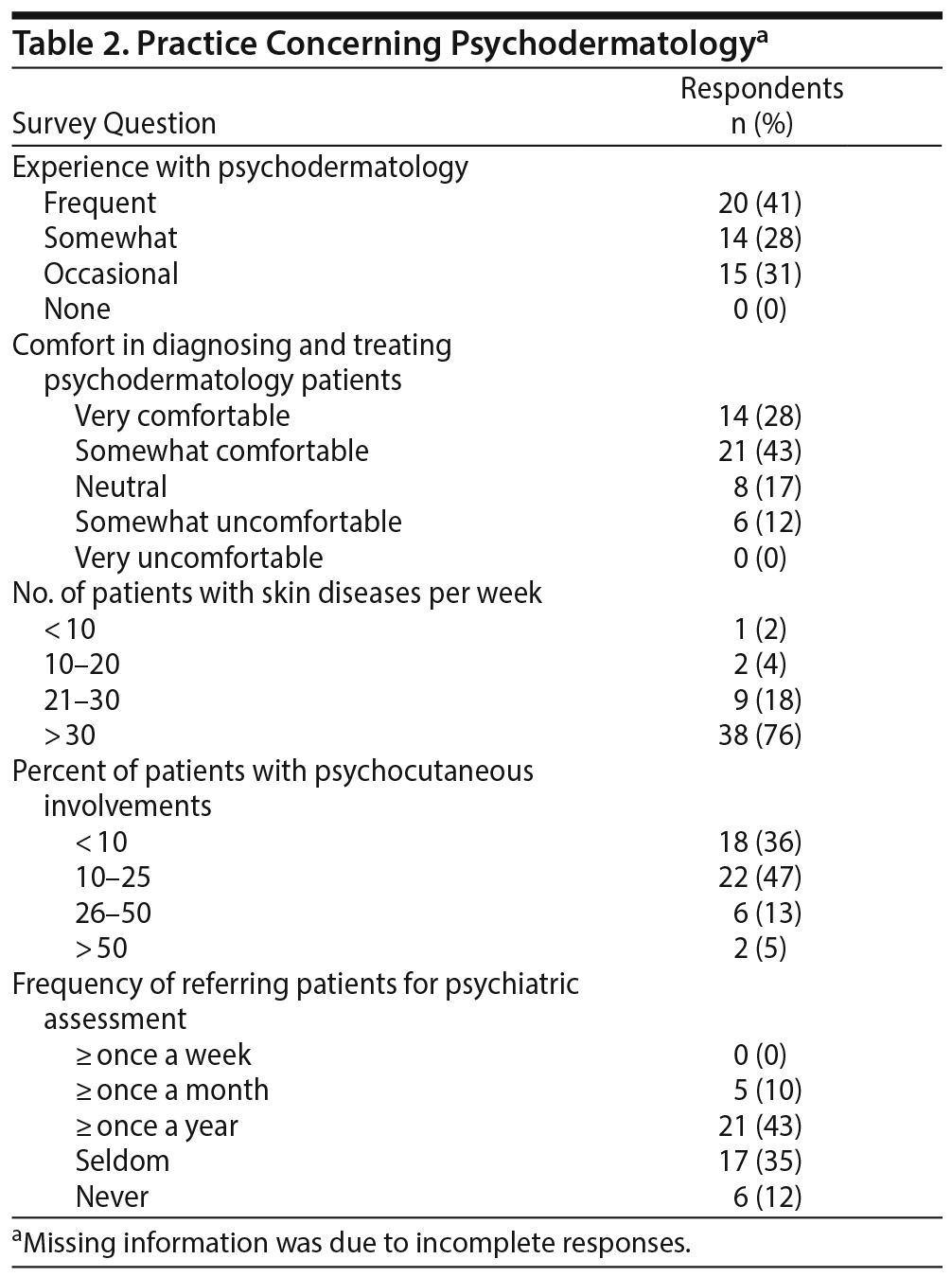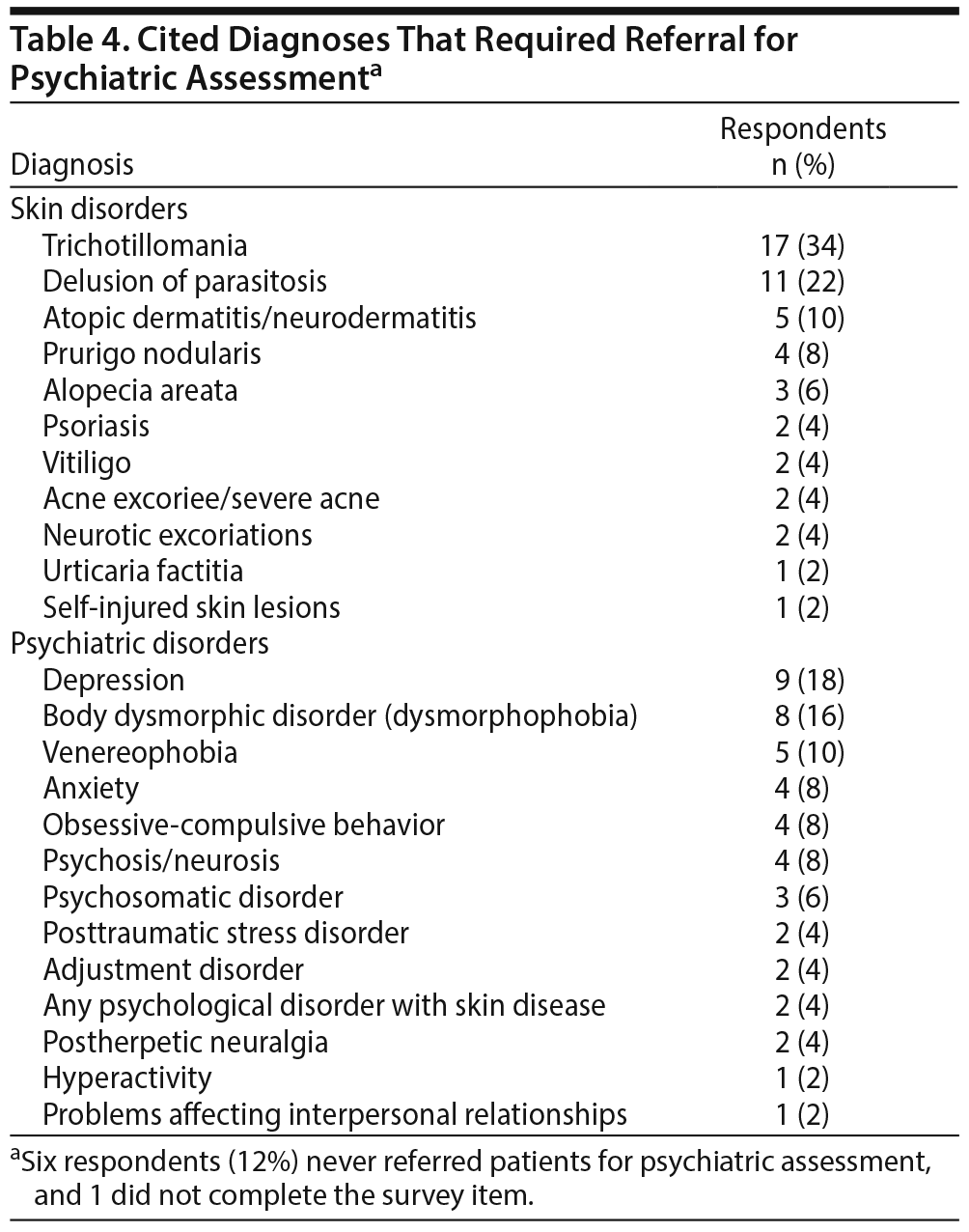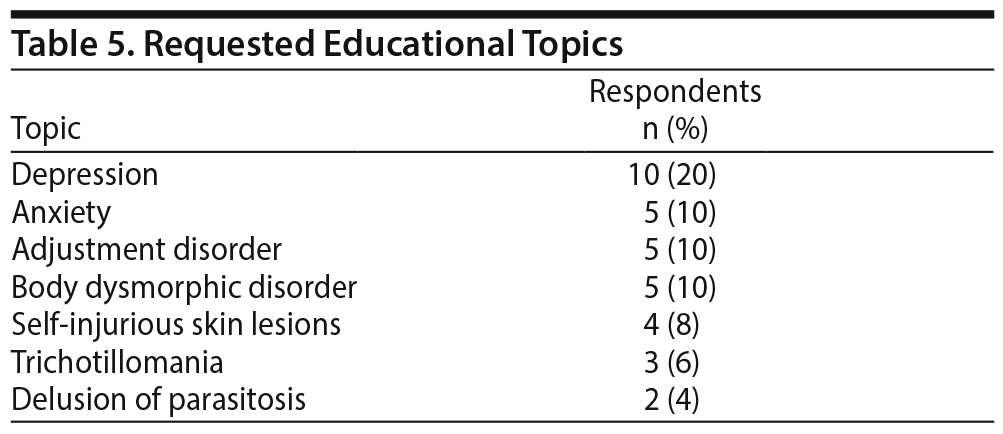Objective: Patients with skin diseases often have psychological problems and complications that require assessment and treatment. The main objective of this study was to explore attentiveness of dermatologists to psychiatric symptoms in their patients.
Methods: A previously validated online questionnaire was used to explore the attitude and experience of dermatologists practicing in the Middle East toward the assessment of the psychiatric needs of their patients. The survey also inquired about awareness of available resources in dealing with psychodermatology. This online survey was conducted between October 2011 and October 2012.
Results: Of 70 invited dermatologists, 57 (81%) completed the survey. Fifteen respondents (31%) received no training and had attended no educational events on psychodermatology. Only 19 respondents (33%) were able to identify psychodermatology as psychiatric components of skin diseases and dermatologic symptoms of psychiatric disorders. Twenty respondents (41%) reported frequent experience with psychodermatology, and 14 (28%) were "very comfortable" in diagnosing and treating psychodermatology patients. Twenty-two respondents (47%) recognized psychocutaneous involvement in 10% to 25% of their patients, while 18 (36%) recognized it in < 10% of their patients. Recognized diagnoses that required referral for psychiatric assessment included trichotillomania (34%), delusion of parasitosis (22%), depression (18%), dysmorphophobias (16%), dermatitis (10%), and venereophobia (10%). Forty-five respondents (90%) were unaware of psychodermatology resources. The majority of respondents expressed interest in education on depression, anxiety, adjustment disorders, and body dysmorphic disorder.
Conclusions: Psychocutaneous involvements are common among dermatologic patients. A large number of the surveyed dermatologists had no training or education in psychodermatology. A lack of familiarity with patient and family resources on psychocutaneous conditions was also evident. These findings support the need for improvement in training and education in psychodermatology.
This work may not be copied, distributed, displayed, published, reproduced, transmitted, modified, posted, sold, licensed, or used for commercial purposes. By downloading this file, you are agreeing to the publisher’s Terms & Conditions.
Attentiveness of Dermatologists in the Middle East to Psychocutaneous Medicine

ABSTRACT
Objective: Patients with skin diseases often have psychological problems and complications that require assessment and treatment. The main objective of this study was to explore attentiveness of dermatologists to psychiatric symptoms in their patients.
Methods: A previously validated online questionnaire was used to explore the attitude and experience of dermatologists practicing in the Middle East toward the assessment of the psychiatric needs of their patients. The survey also inquired about awareness of available resources in dealing with psychodermatology. This online survey was conducted between October 2011 and October 2012.
Results: Of 70 invited dermatologists, 57 (81%) completed the survey. Fifteen respondents (31%) received no training and had attended no educational events on psychodermatology. Only 19 respondents (33%) were able to identify psychodermatology as psychiatric components of skin diseases and dermatologic symptoms of psychiatric disorders. Twenty respondents (41%) reported frequent experience with psychodermatology, and 14 (28%) were "very comfortable" in diagnosing and treating psychodermatology patients. Twenty-two respondents (47%) recognized psychocutaneous involvement in 10% to 25% of their patients, while 18 (36%) recognized it in < 10% of their patients. Recognized diagnoses that required referral for psychiatric assessment included trichotillomania (34%), delusion of parasitosis (22%), depression (18%), dysmorphophobias (16%), dermatitis (10%), and venereophobia (10%). Forty-five respondents (90%) were unaware of psychodermatology resources. The majority of respondents expressed interest in education on depression, anxiety, adjustment disorders, and body dysmorphic disorder.
Conclusions: Psychocutaneous involvements are common among dermatologic patients. A large number of the surveyed dermatologists had no training or education in psychodermatology. A lack of familiarity with patient and family resources on psychocutaneous conditions was also evident. These findings support the need for improvement in training and education in psychodermatology.
Prim Care Companion CNS Disord 2017;19(2):16m02080
https://doi.org/10.4088/PCC.16m02080
© Copyright 2017 Physicians Postgraduate Press, Inc.
aDepartment of Psychiatry and Behavioral Sciences, College of Medicine and Health Sciences, United Arab Emirates University, United Arab Emirates
bMedical Innovations, Kaya Middle East, Dubai, United Arab Emirates
cDepartment of Psychiatry and Behavioral Sciences, College of Medicine, Central Michigan University, Saginaw, Michigan
*Corresponding author: Ossama T. Osman, MD, College of Medicine and Health Sciences, United Arab Emirates University, PO Box 17666, Alain, Abu Dhabi 00000, United Arab Emirates ([email protected]).
Patients with dermatologic disorders often have significant psychiatric problems as a result of their skin condition.1 These symptoms are often overlooked and undertreated. Successful treatment requires psychiatric intervention, and many of these patients depend on their dermatologists for assessment and proper referral.1,2 Thus, training dermatologists to assess the psychological needs of these patients deserves heightened attention.3 Examples of psychological needs include low self-esteem, social isolation, withdrawal, anxiety, depression, and sleep disturbances.4-6 Moreover, psychological distress is known to exacerbate dermatosis, which is amenable to psychopharmacologic and cognitive-behavioral therapies.2
Psychodermatologic disorders can be classified into 4 main categories.2,6 The first category is psychophysiologic disorders, including skin conditions exacerbated by stress such as psoriasis, atopic dermatitis, urticaria, pruritus, alopecia, and acne. The second category is psychiatric disorders with dermatologic symptoms, which include primarily psychiatric disorders with psychopathology involving the skin such as delusions of parasitosis, trichotillomania, dermatitis artifacta, neurotic excoriations, dysmorphophobias, and psychogenic pruritus. The third category is dermatologic disorders with psychiatric symptoms, including psychological consequences of dermatologic conditions such as vitiligo, alopecia areata, generalized psoriasis, and neurofibroma. Finally, the fourth category is miscellaneous cutaneous sensory syndromes such as psychogenic purpura, pseudopsychodermatologic disease, and suicidal behavior in dermatology patients.
The purpose of this survey was to explore attentiveness of dermatologists in the Middle East to psychocutaneous medicine. The main study objectives were to describe the training and self-reporting skills of these physicians, shed light on the psychiatric needs of regional patients with skin diseases, and assess the necessity for any further education on psychodermatology.
METHODS
Study Sample
This study was an online survey conducted between October 2011 and October 2012 and involved practicing dermatologists who were representative of 7 countries in the Middle East (see Table 1). The study was approved by the Al Ain Medical District Human Research Ethics Committee Review Board.
Sampling Method
Individual electronic messages were sent to 70 dermatologists in the region. The detailed communication explained the study and invited them to complete the survey. Their contact information was gathered from various sources, including attendees of the Dubai Derma Annual International Conference in 2011, social media, and dermatology Web listings. The survey was completed by 57 respondents, yielding a response rate of 81%.
Study Survey
We used a slightly modified (reformatted) version of a survey7 previously developed, piloted, and validated for dermatologists in the United States. The survey assessed the dermatologists’ experience with psychodermatological disorders. The questionnaire explored attitudes toward mental health and the psychiatric needs of patients with skin diseases. Survey items inquired about experience and resources available to dermatologists in dealing with mental health issues. Other surveyed variables were age, sex, location, length of practice, year of graduation from highest training, referral pattern, and comfort in handling psychodermatologic cases.7
Data Collection and Analysis
Data were entered into a SPSS database and analyzed by descriptive statistics. Missing data were due to incomplete responses to survey items.

- Skin pathology adversely impacts mental health.
- Lack of familiarity with psychodermatology is common among physicians caring for patients with skin problems.
- Optimal clinical treatment outcomes of skin disorders require psychological interventions directed toward improving self-esteem and quality of life.
RESULTS
Fifty-seven dermatologists completed this online survey. Their characteristics are shown in Table 1. Thirty-one respondents (57%) had more than 10 years practice experience, and 38 (68%) were men. The United Arab Emirates was their most common country of practice (47%).
Table 2 shows the survey responses concerning psychodermatology practices. Twenty respondents (41%) had frequent experience with psychodermatology, but only 14 (28%) were very comfortable in diagnosing and treating psychodermatology patients (Table 2). Thirty-eight respondents (76%) evaluated more than 30 patients with skin diseases per week, and 22 (47%) identified psychodermatology in 10% to 25% of their patients. Twenty-one respondents (43%) referred more than 1 patient for psychiatric assessment annually (Table 2). Nineteen respondents (33%) were able to define psychodermatology as psychiatric aspects of skin diseases as well as dermatologic manifestations of psychiatric disorders.
Table 3 shows the number of patients seen per month with psychological components associated with common skin diseases: acne, alopecia areata, vitiligo, atopic dermatitis, psoriasis, and hyperhidrosis. As an example, 22 respondents (47%) had more than 10 patients per month with acne associated with psychological symptoms.
Table 4 shows all cited diagnoses that required referral for psychiatric assessment. The most common diagnoses were trichotillomania (34%), delusion of parasitosis (22%), depression (18%), body dysmorphic disorder (16%), dermatitis (10%), and venereophobia (10%). Fifteen respondents (31%) had no training and had attended no educational events on cutaneous disorders with psychological components. Forty-five respondents (90%) were unaware of any patient or family resources on psychodermatology. Thirty-nine respondents (78%) expressed interest in attending educational events on psychodermatology, 10 (20%) were indecisive, and 1 (2%) showed no interest. The most suggested topics are listed in Table 5.
DISCUSSION
Several studies1,2 have shown the importance of recognizing the influence of various skin pathologies on the mental health of patients. As a principal organ of reflection and expression, the skin is linked to the psyche embryologically, biologically, and developmentally.4-6 Therefore, optimal clinical treatment outcomes of skin disorders may require psychological interventions directed toward improving self-esteem and quality of life.3
Patients with skin diseases often seek help from dermatologists while ignoring their psychosocial problems. Many also decline necessary referrals to psychiatric services, and, therefore, dermatologists become solely responsible for assessing psychiatric problems.1 However, skills to carry out these responsibilities are not typically attained in dermatology training.
This study is the first to evaluate the experience, skills, and attitudes of dermatologists in our region toward psychodermatologic medicine. The results show the psychological needs of many patients are incompletely fulfilled, especially with respect to access to available resources and support. Examples of such resources include the Association for Psychoneurocutaneous Medicine of North America,8 European Society for Dermatology and Psychiatry,9 Psychodermatology UK,10 and Japanese Society of Psychosomatic Dermatology.11
Our results are consistent with reports7,12-15 from the United States, Turkey, and Pakistan. The majority of the surveyed dermatologists in our study and in others7,12,13 showed interest in workshops, conferences, case presentations, and other educational activities addressing psychodermatology.
As many psychodermatologic cases are seen in hospital-based settings, provision of sufficient psychiatric consultation services becomes a necessity. It is worth emphasizing that future studies are needed to assess the availability of adequate psychiatric services in the Middle East. In an online survey in the United Kingdom,3 dermatologists indicated that patients who required psychological and psychiatric interventions had inadequate access to psychocutaneous medicine resources.
In another study,7 only 18 (18%) of 102 dermatologists in the United States had a clear understanding of psychodermatology, and only 42 (42%) were very comfortable in diagnosing and treating psychocutaneous diseases. Acne, dermatitis, psoriasis, delusion of parasitosis, neurotic excoriations, and trichotillomania were identified diagnoses that required psychiatric referral or intervention. Similar to our findings, most of the respondents were unaware of patient or family resources on psychocutaneous diseases.7
The most frequent skin diseases associated with psychiatric problems reportedly seen by Turkish dermatologists were psoriasis, acne, alopecia areata, and pruritus.12 Depression was found to be common in patients with psoriasis.12 It is worth noting that vitiligo and hyperhidrosis are especially common in our region and that these patients often require specialized psychological support or psychiatric treatment.
Similar to previous studies,6-8 most dermatologists in our survey expressed interest in education on depression, adjustment disorder, and anxiety. In the US study,6 a high degree of interest was expressed in education on self-injury skin lesions, because neurotic excoriation was a common condition.
This study has 2 important limitations. The first is that we were unable to identify the number of dermatologists practicing in the region. Therefore, the representativeness of the sample and the generalizability of our results are uncertain. The second limitation is that the number of participants was relatively small. Thus, follow-up studies are advised to include much larger samples.
In conclusion, our results show a need for training and educational activities on psychocutaneous disorders in the Middle East. Information gaps are identified, especially with respect to awareness of available resources for patients or families. We recommend incorporating training on psychodermatology in both dermatology and psychiatry residency programs.
Submitted: December 7, 2016; accepted February 20, 2017.
Published online: April 27, 2017.
Potential conflicts of interest: None.
Funding/support: None.
REFERENCES
1. Nowak DA, Wong SM. DSM-5 update in psychodermatology. Skin Therapy Lett. 2016;21(3):4-7. PubMed
2. Shenefelt PD. Psychodermatological disorders: recognition and treatment. Int J Dermatol. 2011;50(11):1309-1322. PubMed doi:10.1111/j.1365-4632.2011.05096.x
3. Lowry CL, Shah R, Fleming C, et al. A study of service provision in psychocutaneous medicine. Clin Exp Dermatol. 2014;39(1):13-18. PubMed doi:10.1111/ced.12235
4. Mufaddel A, Osman OT, Almugaddam F. Adverse cutaneous effects of psychotropic medications. Expert Rev Dermatol. 2013;8:681-691. doi:10.1586/17469872.2013.846515
5. Osman OT. The skin as a mode of communication. Expert Rev Dermatol. 2010;5:493-496. doi:10.1586/edm.10.46
6. Osman OT, Mudaddel A, Almugaddam F, et al. The psychiatric aspects of skin disorders. Expert Rev Dermatol. 2011;6:195-209. doi:10.1586/edm.11.10
7. Jafferany M, Vander Stoep A, Dumitrescu A, et al. The knowledge, awareness, and practice patterns of dermatologists toward psychocutaneous disorders: results of a survey study. Int J Dermatol. 2010;49(7):784-789. PubMed doi:10.1111/j.1365-4632.2009.04372.x
8. Association for Psychoneurocutaneous Medicine of North America. http://www.psychodermatology.us/. Accessed April 10, 2017.
9. European Society for Dermatology and Psychiatry. http://psychodermatology.net/. Accessed April 10, 2017.
10. Psychodermatology UK. https://www.psychodermatology.co.uk/. Accessed April 10, 2017.
11. Japanese Society of Psychosomatic Dermatology. http://jpsd-ac.org/en/. Accessed April 10, 2017.
12. Ocek T, Kani AS, BaÅŸ A, et al. Psychodermatology: knowledge, awareness, practicing patterns, and attitudes of dermatologists in Turkey. Prim Care Companion CNS Disord. 2015;17(2):doi:10.4088/PCC.14m01628. PubMed doi:10.4088/PCC.14m01628
13. Khawaja AR, Bokhari SM, Tariq R, et al. Disease severity, quality of life, and psychiatric morbidity in patients with psoriasis with reference to sociodemographic, lifestyle, and clinical variables: a prospective, cross-sectional study from Lahore, Pakistan. Prim Care Companion CNS Disord. 2015;17(3):doi:10.4088/PCC.14m01629. PubMed doi:10.4088/PCC.14m01629
14. Jafferany M. Psychodermatology: a guide to understanding common psychocutaneous disorders. Prim Care Companion J Clin Psychiatry. 2007;9(3):203-213. PubMed doi:10.4088/PCC.v09n0306
15. Mufaddel A, Osman OT, Almugaddam F, et al. A review of body dysmorphic disorder and its presentation in different clinical settings. Prim Care Companion CNS Disord. 2013;15(4):doi:10.4088/PCC.12r01464. PubMed doi:10.4088/PCC.12r01464
This PDF is free for all visitors!
Save
Cite





